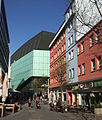Brückstrasse district
| Brückstrasse | |
|---|---|
| Street in Dortmund | |
| Entrance to Brückstrasse | |
| Basic data | |
| place | Dortmund |
| District | Downtown |
| Newly designed | 1990s |
| Connecting roads | Kampstrasse, Wallring |
| Subway stations | Kampstrasse, Reinoldikirche, Central Station |
| use | |
| Road design | Pedestrian zone |
The Brückstrasse district is a district in the north of Dortmund city center . It is bounded by Kampstrasse and the Platz von Leeds in the south, Hansastrasse in the west, Königswall in the north and the Kuckelke in the east. Large parts of the district are designated as a pedestrian zone . It is known for international food stalls and nightlife .
history
The Brückstrasse is part of the old trade route from Cologne to the Baltic Sea. It was likely to be found in the cityscape of Dortmund as early as the 9th century before the first city expansion.
Until the early 1990s, Brückstrasse was extremely shabby and neglected. At the time it was a meeting place for the drug and red light scene. In particular, the adjacent square of Leeds to the south was known nationwide for its drug scene in the 1980s. As a result, the city of Dortmund started a project to upgrade the street with funding. Many houses on Brückstrasse have been extensively renovated. Above all, care was taken to make the facades colorful.
Another step was the construction of the Dortmund Concert Hall , the Orchestra Center NRW and the establishment of the Dortmund Adult Education Center in the former elite café and today's Löwenhof monument . The street was further strengthened as a cultural mile and also upgraded architecturally and qualitatively.
location
Brückstrasse is located in the northern part of the city. It begins at the intersection with Westen- and Ostenhellweg at the Reinoldikirche and extends to the castle gate in the immediate vicinity of the main train station , thus connecting the city center with the northern part of the city. The street can be reached by underground via the stops Hauptbahnhof, Kampstraße or Reinoldikirche.
shops
Snack bars (gastronomy) from all over the world dominate today's Brückstrasse. There are also retail stores and services such as hairdressing salons and at the “outer” end (towards Wallring) the Schauburg cinema . There are hotels nearby.
photos
Historical views
literature
- Mathias Austermann: Building blocks and found objects . The special note of the Brückstrasse. In: City of Dortmund - Monument Authority (Hrsg.): Dortmunder Denkmalhefte . No. 3 , 2013, ISSN 2192-9408 ( dortmund.de [PDF; 5.2 MB ; accessed on November 25, 2013]).
Web links
- History and historical pictures of the Löwenhof Elite Café ( Memento from July 14, 2014 in the Internet Archive )
- YouTube video about Brückstrasse 1998
Individual evidence
- ↑ Norbert Reimann: The becoming of the city . In: Stadtarchiv Dortmund (Hrsg.): History of the city of Dortmund . Harenberg Verlag, Dortmund 1994, ISBN 3-611-00397-2 , p. 17, 36 .
Coordinates: 51 ° 30 '59.1 " N , 7 ° 27'56.8" E











